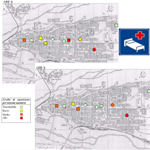The Hospital System and the Urban Resilience
Abstract
The concept of resilience is critical when addressing the issue of natural hazards.
The role of an urban planner is to analyze the territorial system, consisting of several functional sub-systems (housing, education, health, etc..) and its vulnerability. In order to have a specific knowledge of the territory in question, before the occurrence of a disaster it would be necessary, for each functional system, analyze various aspects and define risk simulations. In a city, in fact, there are strategic elements that should not lose functionality during or following a natural event; the definition of specific scenarios could put structures exposed to risk on safety in order not to compromise the system.
In this paper I report a specific experience of research carried out within the hospital system that, in case of occurrence of a natural event, is often simultaneously exposed, and therefore need of rescue, and it is a dispenser of rescue. It’s considered strategic because it has to ensure the functionality of its service regardless of the occurrence of external events, such as natural ones; its functionality must be ensured in the continuum. In today is not very thorough the scientific literature about the analysis of the hospital system in respect of such events.
Given the importance of the theme there are several initiatives, also promoted by The Italian Civil Protection, in particular the drafting of hospital emergency plans, which cover issues such as fire, road accidents, floods, ... Interesting was the collaboration between the Italian Civil Protection Department with Applied Technology Council for the planning of a background paper intended for the preparation of earthquake emergency plans, within which there are also aspects of prevention such as the evaluation of seismic vulnerability of hospitals themselves.
The described methodology has allowed the definition of risk simulations for the hospital system, starting from the determination of qualitative and quantitative indices of hazard, vulnerability and exposure in support of plan emergency hospital. Specific focus was directed to the exposure, determined dynamically, going to know how the situation changes in the hospital complex, depending on the passing of hours a day. In these scenarios we introduced the parameter “time”, concept of the time policies (actions for the quality of the urban conditions of life of its citizens, acting on the aspects of urban functions and times of their coordination).
Case study is the town of Cuneo and the considered event is the earthquake.
The new “Planning and emergency hospital Plans” could well be a step forward for the safety of the territory. These could be an integral part of the town civil protection plans (not only dedicated to the emergency but also to forecast), in turn attached to urban plans in order to become operational tools of strategies and policies needed to increase urban resilience.
Downloads
References
Battaglia L., Pirlone F. (in corso di stampa) “Il sistema sanitario: approccio per una corretta accessibilità spazio/temporale”, in Culture e Tecniche per l’accessibilità in XIX Conferenza Internazionale Vivere e camminare in città, Brescia
Cutini A. (1995) “Continuità dei servizi a rete nella città sicura”, in Sanfilippo E. D., Piano e progetto nelle aree a rischio sismico, Gangemi, Roma,
De Soetis A., Di Martino M.P., Di Pasquale G., Nuti C., Sanò S., Homes W., Lagorio J., Phipps, Poland C., Tokas C. (2000) Raccomandazioni congiunte USA-Italia per il miglioramento della sicurezza sismica degli ospedali Italiani, SSN, Presidenza del Consiglio dei Ministri
De Soetis A., Di Pasquale G., Gaiardi S., Sanò S., Foster B., Gillengerten J. (2002) Raccomandazioni congiunte Stati Uniti-Italia per l’Elaborazione di Piani di Emergenza Sismica negli Ospedali Italiani
Fera G. (1991) La città antisismica, Gangemi, Roma
Galderisi A. (2004) Città e terremoti, Metodi e tecniche per la mitigazione del rischio sismico, Gangemi Editore, Roma
Menoni S. (1997), Pianificare e incertezza, Elementi per la valutazione e la gestione dei rischi territoriali, FrancoAngeli, Milano
Mercandino A. (2001), Urbanistica tecnica, Il sole 24 ore, Milano,
Ministero della salute (2000) Raccomandazioni per il miglioramento della sicurezza sismica e della funzionalità degli ospedali
Nuti C., Santini S., Di Pasquale F. (1997) “Indagini per la valutazione della vulnerabilità del patrimonio ospedaliero italiano”, Atti del 9° Convegno Nazionale L’Ingegneria Sismica in Italia
Nuti C., Vanzi I., Santini S. (1998) “Seismic risk of italian hospitals”, Proceedings of the 11 ECEE, Paris
Pirlone F. (2009), I rischi naturali nelle prassi ordinarie di pianificazione e gestione urbanistica. L’importanza della temporalità nella sicurezza del territorio, Alinea Editrice, Firenze
Regione Lombardia (2012), Linee di indirizzo per la redazione del Piano di emergenza nelle strutture sanitarie
Ugolini P. (2004) Rischio sismico. Tutela e valorizzazione del territorio e del centro storico, FrancoAngeli, Milano

Copyright (c) 2014 Tema. Journal of Land Use, Mobility and Environment

This work is licensed under a Creative Commons Attribution 4.0 International License.
Authors who publish in this journal agree to the following:
1. Authors retain the rights to their work and give in to the journal the right of first publication of the work simultaneously licensed under a Creative Commons License - Attribution that allows others to share the work indicating the authorship and the initial publication in this journal.
2. Authors can adhere to other agreements of non-exclusive license for the distribution of the published version of the work (ex. To deposit it in an institutional repository or to publish it in a monography), provided to indicate that the document was first published in this journal.
3. Authors can distribute their work online (ex. In institutional repositories or in their website) prior to and during the submission process, as it can lead to productive exchanges and it can increase the quotations of the published work (See The Effect of Open Access)
